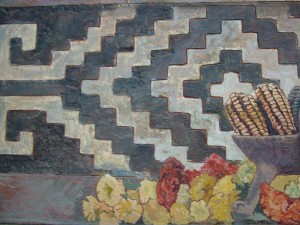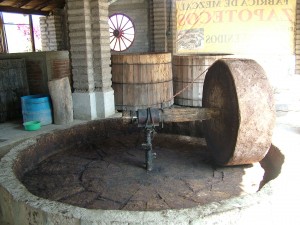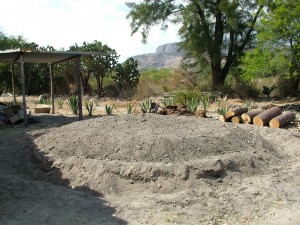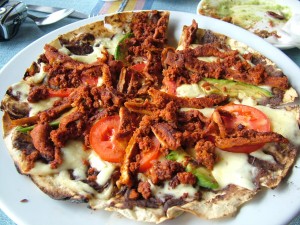One of the archaeological sites we will visit is the ancient city of Mitla (Mictlan, in Nahuatl, land of the dead). Here are two Nahua glyphs for mictlan. And here is an article (in Spanish) about Mictlan. The site had its own Zapotec name, but the Aztec colonizers’ name for the place stuck, right through to the present.
The Spanish colonizers put their Christian church right in the middle of the pre-Columbian settlement.
One of the buildings behind the church still retains vestiges of pre-Columbian mural paintings of a type very reminiscent of pre-Columbian and early colonial codices from this region. The pictographic texts would have narrated histories of town founding, leadership, and genealogies of leading families. While this is a Zapotec community, the stylistics of the pictorials are similar to codices made by the Mixtecs.

Platform with ruins of palace on top. Notice geometric mosaic designs on the facade. Red paint on wall, a modern reconstruction. (Photo, S. Wood, Nov. 2013)
The ruined city of Mitla also has two tombs that have been excavated and that you can visit. Items have been removed, but one can still see mosaics in these spaces, just as they are still visible inside some of the palaces.
Early Twentieth-Century Photographs
The following images of Mitla are possibly from the 1930s or 40s. The photographer is not known, and the slides are not marked with locations or dates. The scenes of Mitla date from prior to the archaeological restoration of the site.
Geometric Patterns in Street Art
The following examples of street art that incorporates geometric patterns were observed on the streets of Oaxaca in 2009.
Arturo García Bustos Mural
Note the incorporation of geometric patterns in the García Bustos mural in the municipal palace on the zócalo.
Rancho Zapata
On our way to Mitla, we will be stopping for lunch at Rancho Zapata, the restaurant and mezcal plant run by Benevá. We will place our orders from the menu, and while we wait for our food, we will take the tour of the mezcal-making process. Mezcal (from the Nahuatl terms metl, an agave, and ixcalli, oven-cooked agave) is an alcoholic beverage made from the maguey, an agave plant. Maguey plants grow across a large part of Mesoamerica, and in many of its cultures, they have an almost sacred role as an essential component of the diet, a role in ritual, and associations with legends and myths.
The maguey produced a pre-Columbian beverage called pulque (fermented by not distilled). Distilled beverages of Mesoamerica, such as mezcal and tequila, probably date from the period of Spanish colonization. (Tequila is a mezcal that is made specifically from the blue agave grown in selection regions, such as the state of Jalisco.) Mezcal has been made for at least two centuries. Despite the similarity of its name, mezcal is not related to mescaline, a psychedelic drug. [Source: Virginia B. de Barrios, A Guide to Tequila, Mezcal, and Pulque (Mexico City: Minutiae Mexicana, 2002).]


















